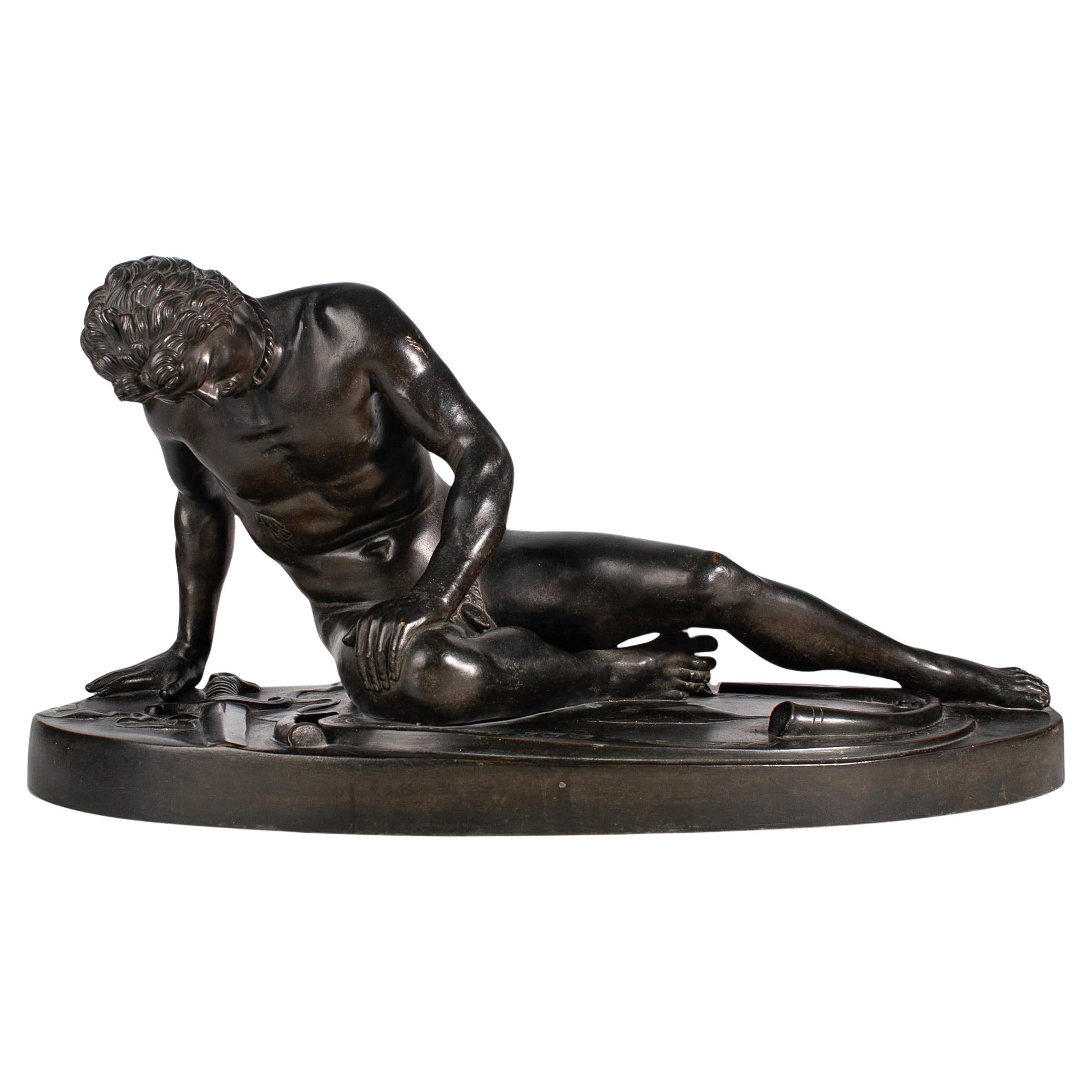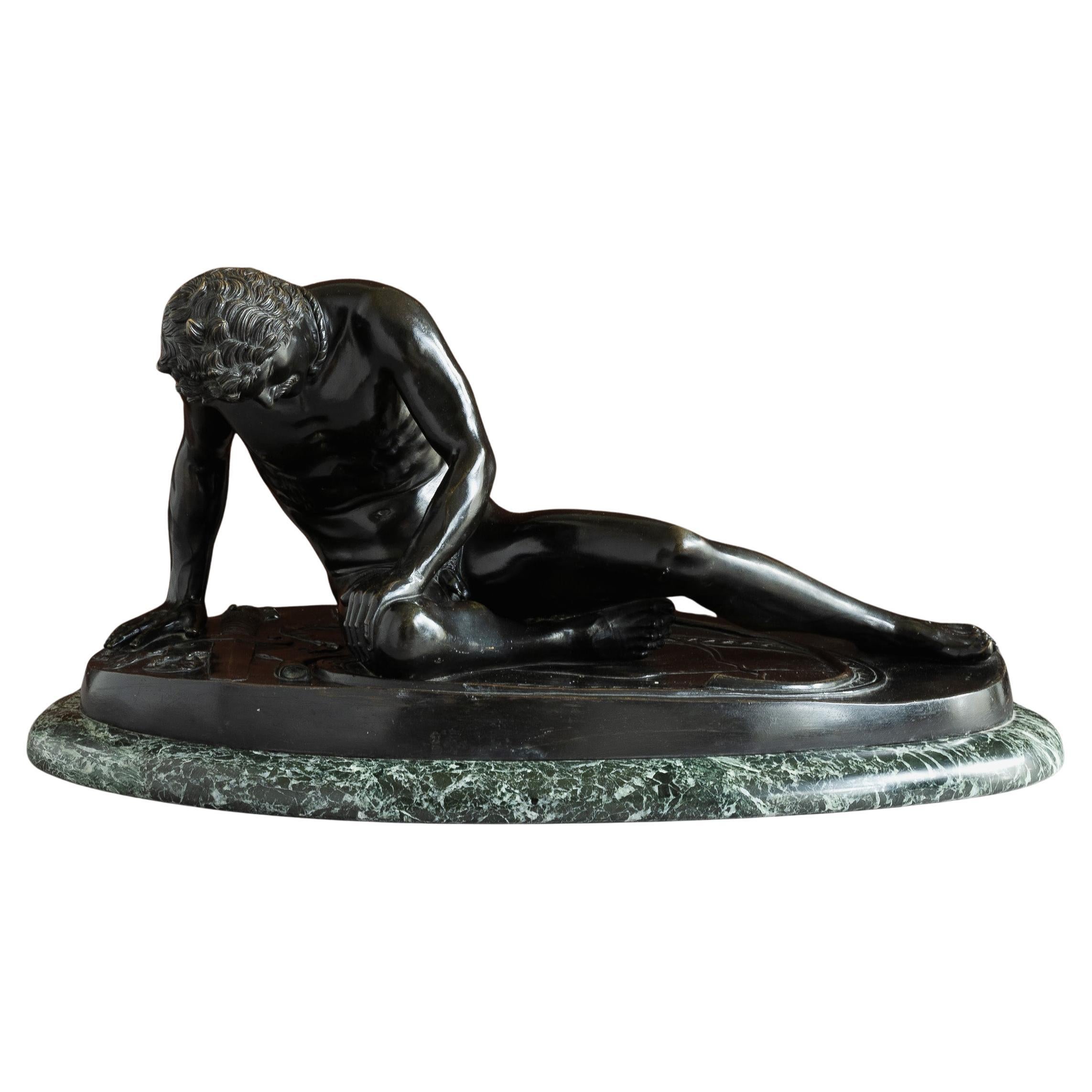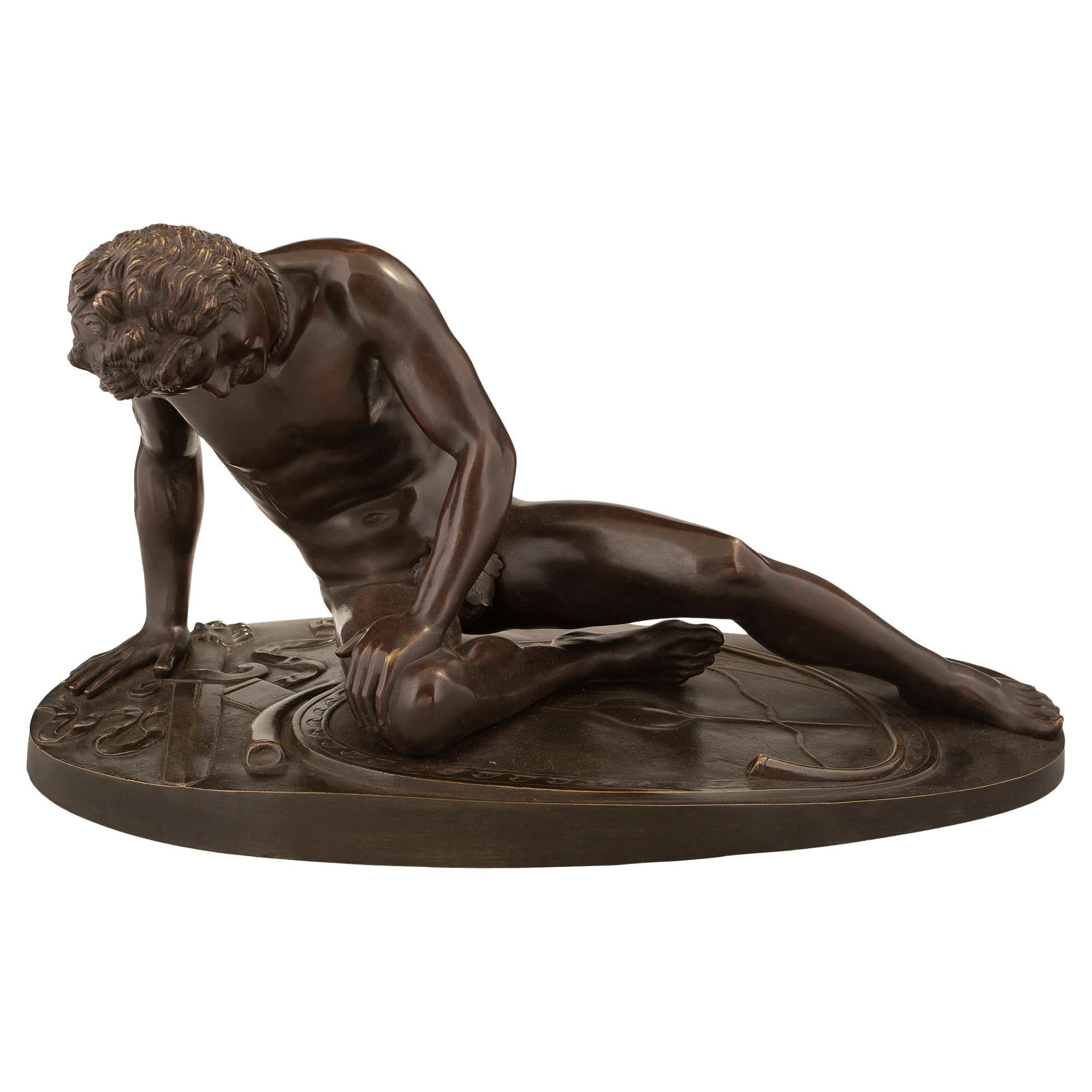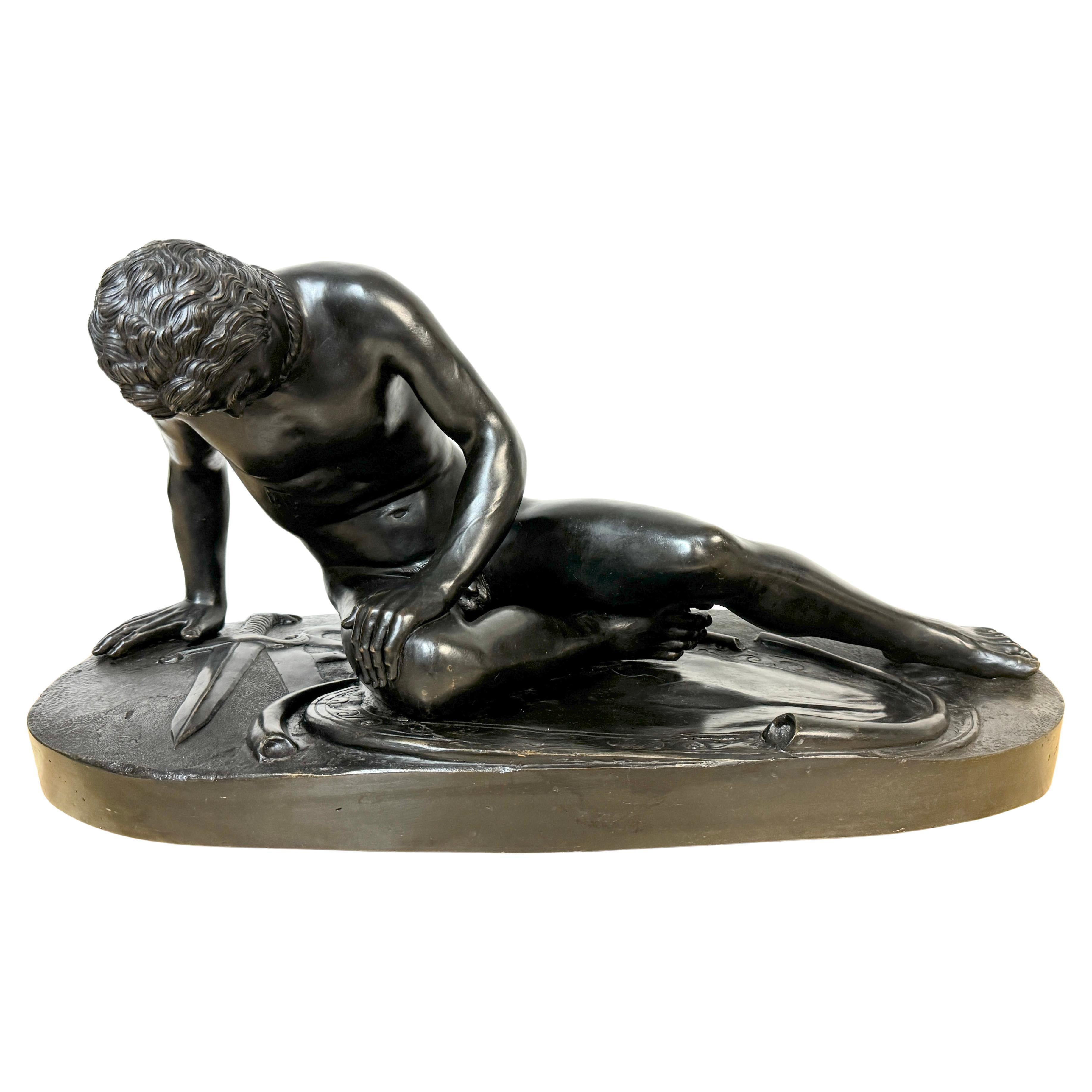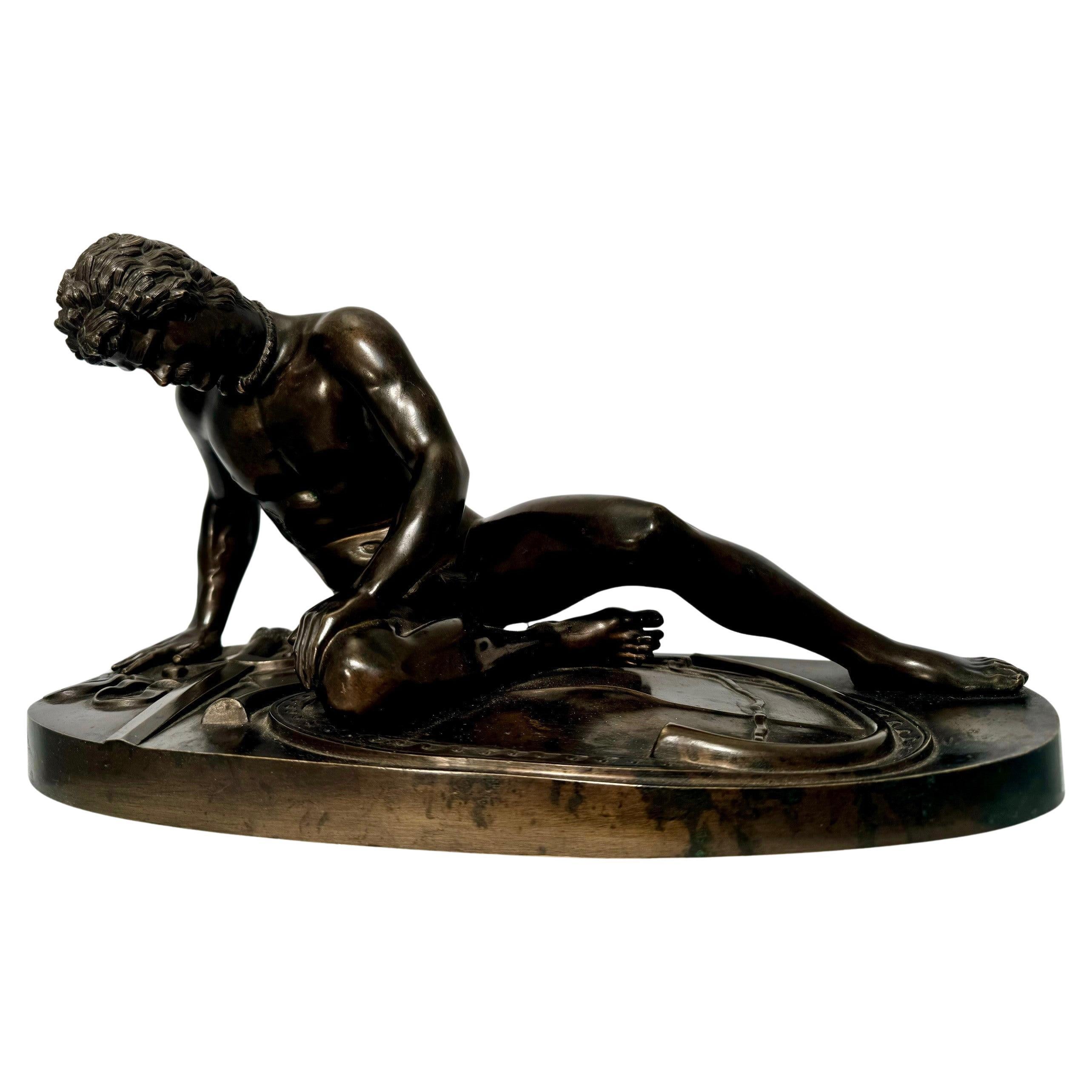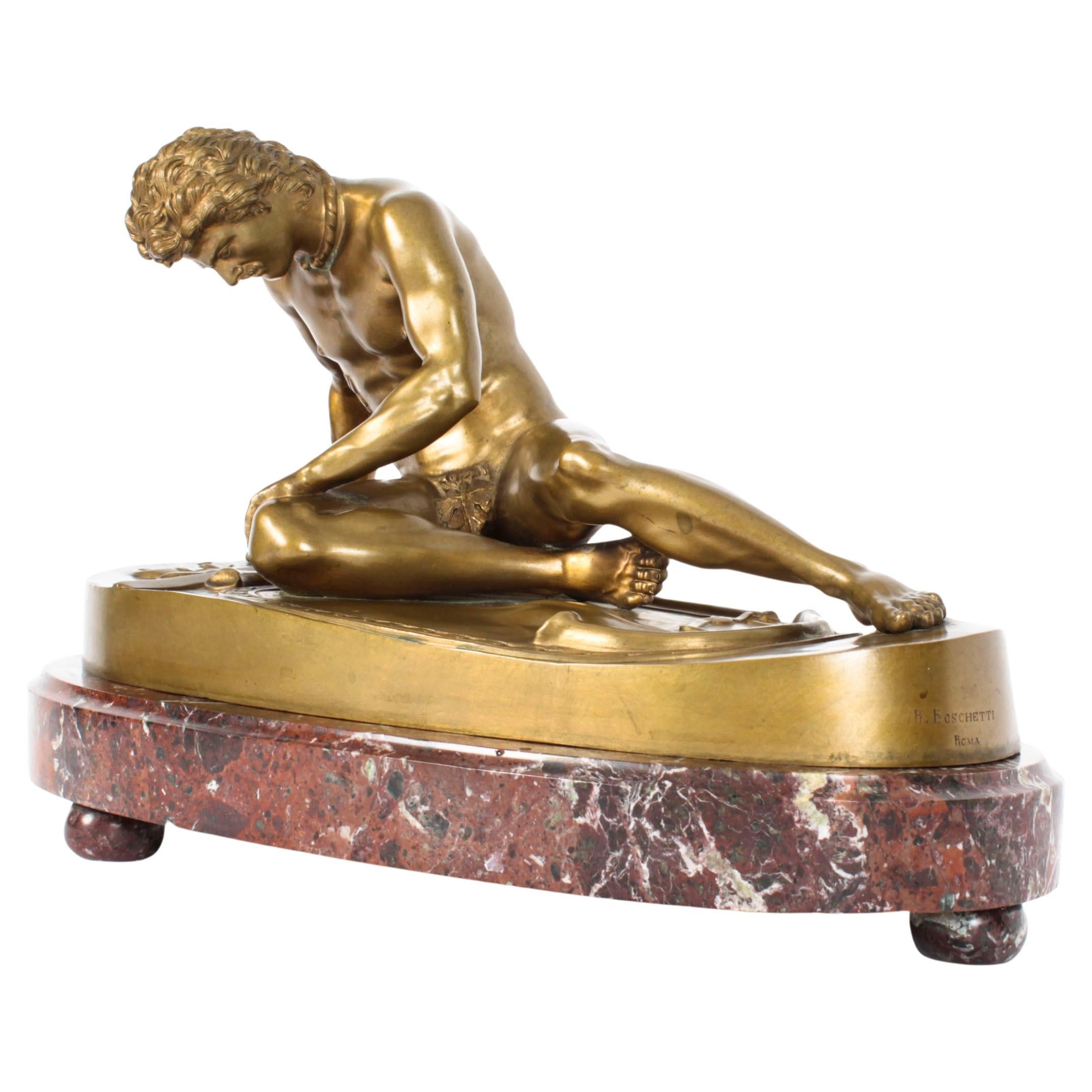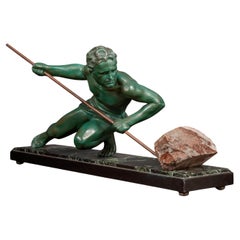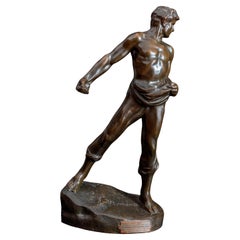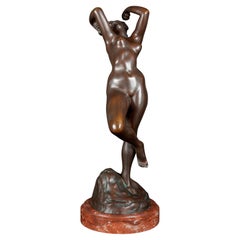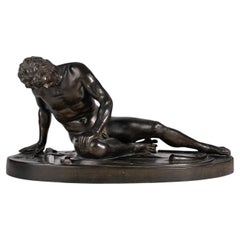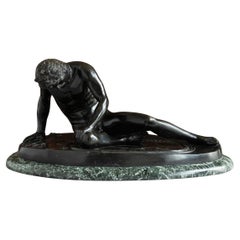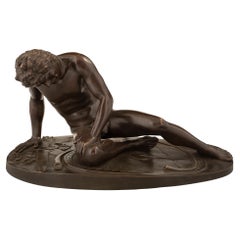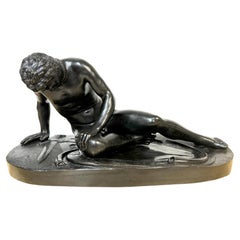Items Similar to "The Dying Gaul": Bronze sculpture 'Gala Morente' cast by CHIURAZZI NAPOLI
Want more images or videos?
Request additional images or videos from the seller
1 of 15
"The Dying Gaul": Bronze sculpture 'Gala Morente' cast by CHIURAZZI NAPOLI
$11,909.45
£8,868.15
€10,000
CA$16,313.56
A$18,191.46
CHF 9,491.53
MX$223,216.13
NOK 120,812.07
SEK 114,466.81
DKK 76,126.37
Shipping
Retrieving quote...The 1stDibs Promise:
Authenticity Guarantee,
Money-Back Guarantee,
24-Hour Cancellation
About the Item
The Dying Gaul.
- Description of the Work:
A Celtic warrior lies nude, half-reclining on his shield, his body contorted by pain. His right hand touches the ground while his face, marked by suffering, is turned downwards. His left hand rests on his bent right leg, the foot of which rests beneath his almost fully extended left leg. Blood flows profusely from his chest, betraying a serious wound.
This warrior is distinguished by his mustache, long, disheveled hair, and torques, a typically Gaulish jewel. His oval shield, equipped with a central, widened spine, is an emblematic weapon of the Celts. A curved trumpet, called a cornu, with its suspension cord, is also represented at the base.
- Historical Context:
Originally, "The Dying Gaul" is a Roman marble sculpture that copies a lost Greek original from the Hellenistic period, probably made in bronze between 230 and 220 BC by Epigonos of Pergamon. This work, also known as the Capitoline Gaul, is exhibited at the Palazzo Nuovo (Rome) in the Capitoline Museums. It represents a wounded Gaulish warrior, naked and slumped on his shield, with abundant hair and a torque around his neck. The sculpture testifies to the Celtic defeat and illustrates the strength of the victorious people, while paying homage to the courage of its adversaries. Discovered in the early 18th century, it was acquired by Pope Clement VII in 1734 and exhibited at the Capitoline Museums. The fame of this statue has led to numerous copies and interpretations, influencing art and emotional representation over the centuries.
- The Foundry:
The Chiurazzi foundry, founded by Gennaro Chiurazzi in Naples in 1870, specialized in reproducing classical and Renaissance sculptures in bronze using the lost wax process. Thanks to the growing demand for copies of renowned museums, the foundry gained international renown, winning prizes at exhibitions in New Orleans and Turin. After Gennaro's death, his sons continued the business by expanding their offer to the production of marble and ceramics. The foundry moved to Rome in 1925 to meet the demand of the capital. In 2011, the company was relaunched by an Arizona company, thus preserving its artistic heritage.
- Different Artistic Currents of the Work:
• Hellenistic Art: The original statue, "The Dying Gaul," is a work of Hellenistic art dating back to the 3rd century BC. It illustrates the dramatic expression and realistic representation of emotions, characteristic of Hellenistic art.
• Realism: The sculpture is a striking example of realism, with detailed attention to facial expressions and anatomical details, aiming to capture pain and suffering in a very realistic way.
• Neoclassicism: In the 18th and 19th centuries, there was a renewed interest in classical works, including those from the Hellenistic period. Copies and interpretations of "The Dying Gaul" were made as part of the Neoclassical movement, which sought to revive the styles and themes of classical antiquity.
• Romanticism: This work can also be associated with Romanticism, an early 19th-century movement that valued intense emotions, drama, and tragic narratives. The figure of the Dying Gaul, with its poignant representation of defeat and pain, aligns well with Romantic sensibilities.
- Dimensions:Height: 11.82 in (30 cm)Width: 22.05 in (56 cm)Depth: 11.03 in (28 cm)
- Style:Hellenistic (Of the Period)
- Materials and Techniques:
- Period:
- Date of Manufacture:Inconnu
- Condition:Wear consistent with age and use.
- Seller Location:Ixelles, BE
- Reference Number:1stDibs: LU10116242392542
About the Seller
No Reviews Yet
Vetted Professional Seller
Every seller passes strict standards for authenticity and reliability
1stDibs seller since 2024
- ShippingRetrieving quote...Shipping from: Ixelles, Belgium
- Return Policy
Authenticity Guarantee
In the unlikely event there’s an issue with an item’s authenticity, contact us within 1 year for a full refund. DetailsMoney-Back Guarantee
If your item is not as described, is damaged in transit, or does not arrive, contact us within 7 days for a full refund. Details24-Hour Cancellation
You have a 24-hour grace period in which to reconsider your purchase, with no questions asked.Vetted Professional Sellers
Our world-class sellers must adhere to strict standards for service and quality, maintaining the integrity of our listings.Price-Match Guarantee
If you find that a seller listed the same item for a lower price elsewhere, we’ll match it.Trusted Global Delivery
Our best-in-class carrier network provides specialized shipping options worldwide, including custom delivery.More From This Seller
View AllAttributed to GUSTAVE LOUIS BUCHET (1888-1963) Bronze statue "L'EFFORT"
By Gustave Buchet
Located in Ixelles, BE
Attributed to GUSTAVE LOUIS BUCHET (1888-1963) Bronze statue "L'EFFORT" or "L'ATHLETE".
Description of the work The statue "L'EFFORT" or "THE MAN LIFTING A STONE" Attributed to Gust...
Category
20th Century Swiss Art Deco Figurative Sculptures
Materials
Bronze
Emile Louis Picault (1833-1915) « LE TRAVAIL » bronze statue
By Émile Louis Picault
Located in Ixelles, BE
Emile Louis Picault (1833-1915) « LE TRAVAIL » bronze statue
The bronze statue 'Le Travail' by Émile Louis Picault is much more than a mere work of art. It embodies the very essence...
Category
Antique 19th Century French Industrial Figurative Sculptures
Materials
Bronze
Jef Lambeaux (1852-1908) “THE SOWER”
By Jef Lambeaux
Located in Ixelles, BE
Jef Lambeaux (1852-1908) “THE SOWER”
Artistic Description:
"The Sower" depicts a vigorous young man, bare-chested, in the act of sowing seeds. The sculpture captures with precision...
Category
Antique Late 19th Century Belgian Art Nouveau Figurative Sculptures
Materials
Bronze
JEF LAMBEAUX (1852 – 1908) Bronze Statue "THE DANCER WITH CASTANETS"
By Jef Lambeaux
Located in Ixelles, BE
JEF LAMBEAUX (1852 – 1908) Bronze Statue "THE DANCER WITH CASTANETS" .
Imagine a sculpture that transcends mere representation to capture the very essence of movement and passion. "...
Category
Antique 19th Century Belgian Art Nouveau Figurative Sculptures
Materials
Bronze
« La Baigneuse » ou « La Nymphe prenant son bain » (1757)
By Étienne Maurice Falconet
Located in Ixelles, BE
Étienne-Maurice Falconet (1716-1791), "The Bather" or "The Nymph Bathing" (1757)
Artistic Explanation:
The Nymph Bathing is a masterpiece of 18th-century French sculpture, created...
Category
Antique 1750s French Baroque Figurative Sculptures
Materials
Bronze
Louis-Ernest Barrias (1841-1905) Bronze Bas-Relief "The Reader"
By Louis Ernest Barrias, Susse Freres
Located in Ixelles, BE
Louis-Ernest Barrias (1841-1905) Bronze Bas-Relief "The Reader".
Bas-Relief: "The Reader" is a bas-relief created by Louis-Ernest Barrias, a renowned 19th-century sculptor. The bas-...
Category
Antique 19th Century French Neoclassical Figurative Sculptures
Materials
Bronze
You May Also Like
Mid-19th Century Grand Tour Bronze Figurative Sculpture 'The Dying Gaul', Italy
Located in North Miami, FL
Mid-19th Century Grand Tour Bronze Figurative Sculpture 'The Dying Gaul', Italy
By: unknown
Material: bronze, copper, metal
Technique: cast, molded, polished, metalwork, patinated
D...
Category
Antique 1850s Italian Grand Tour Figurative Sculptures
Materials
Metal, Bronze, Copper
Antique Bronze Figure of The Dying Gaul
Located in London, GB
A bronze figure of the dying Gaul after the Antique, on verde marble base, Italian, nineteenth century.
Dimensions: 30.5cm (12") High, 35cm (13¾") Wide, 65cm (25½") Long, 13.5cm (5¼...
Category
Antique 19th Century Italian Classical Greek Figurative Sculptures
Materials
Marble, Bronze
Italian 19th Century Patinated Statue of ‘The Dying Gaul’
Located in West Palm Beach, FL
A handsome Italian 19th century patinated statue of 'The Dying Gaul'. The statue is raised by an oval shaped terrain like designed base. The fallen gladiato...
Category
Antique 19th Century Italian Figurative Sculptures
Materials
Bronze
Large Italian Grand Tour Bronze Sculpture "Dying Galata" /Dying Gaul, C. 1875
Located in West Palm Beach, FL
Large Italian Grand Tour Bronze Sculpture "Dying Galata"/Dying Gaul, C. 1875, Attributed to Naples Foundry
A remarkable large Italian Grand Tour bronze sculpture titled "Dying Galata" or "Dying Gaul," dating circa 1875 and attributed to the renowned Naples Foundry. This exquisite piece, an expertly cast bronze, retains its original black-brown patina and boasts a substantial size, standing 12 inches high, 26.5 inches wide, and 13.5 inches deep. It is a distinguished example of the iconic Grand Tour sculptures, which were popular souvenirs for affluent travelers during the 19th century.
The sculpture is a faithful rendition of the ancient Roman marble statue "The Dying Gaul," also known as "The Dying Galatian" or "The Dying Gladiator." The original marble, now housed in the Capitoline Museums in Rome, is a Roman copy of a lost Greek bronze sculpture...
Category
Antique 19th Century Italian Grand Tour Figurative Sculptures
Materials
Bronze
Grand Tour bronze figure of “The Dying Gaul”, After The Antique
Located in Montreal, QC
A late 19th century Grand Tour bronze figure of “The Dying Gaul”, after the antique. The Dying Gaul depicts a warrior in his final moments, next to his shield and sword, his face contorted in pain just before he collapses from the mortal wound to his chest The original marble figure, which is in the Capitoline museum in Rome is thought to be a Roman copy of a Greek sculpture in Bronze. As an image of a vanquished enemy, the sculpture embodies courage in defeat, self-possession in the face of death, and the recognition of nobility in an alien race.
“The Dying Gaul” was found in Rome with another ancient marble...
Category
Antique Late 19th Century Italian Classical Greek Figurative Sculptures
Materials
Bronze
Antique Bronze Sculpture of the Dying Gaul by B Boschetti Rome, 19th Century
By Benedetto Boschetti
Located in London, GB
This is a truly magnificent antique Italian Grand Tour figural golden patinated bronze sculpture depicting a wounded gladiator known as "The Dying Gaul", and signed B Boschetti...
Category
Antique 1830s Italian Figurative Sculptures
Materials
Bronze
